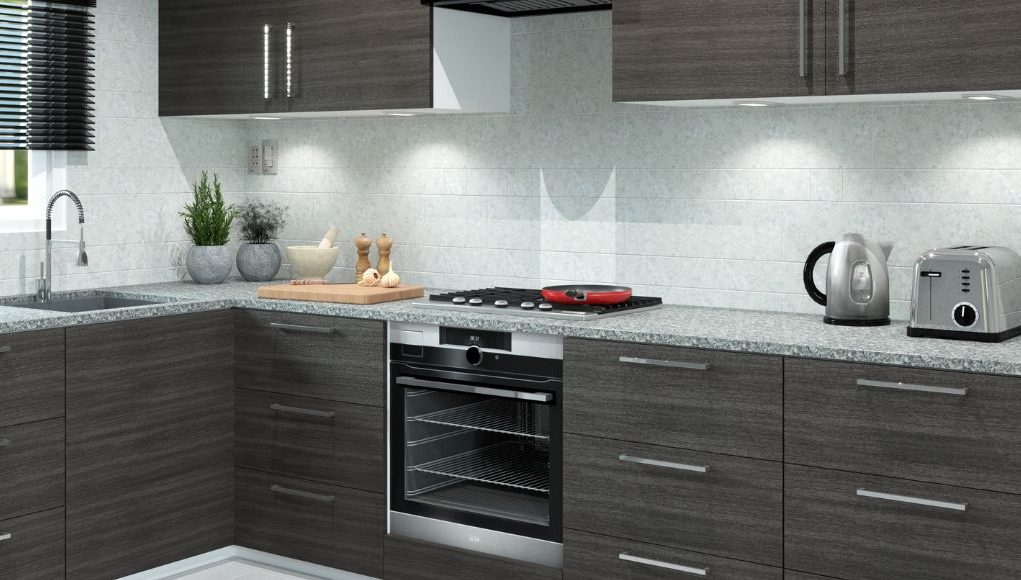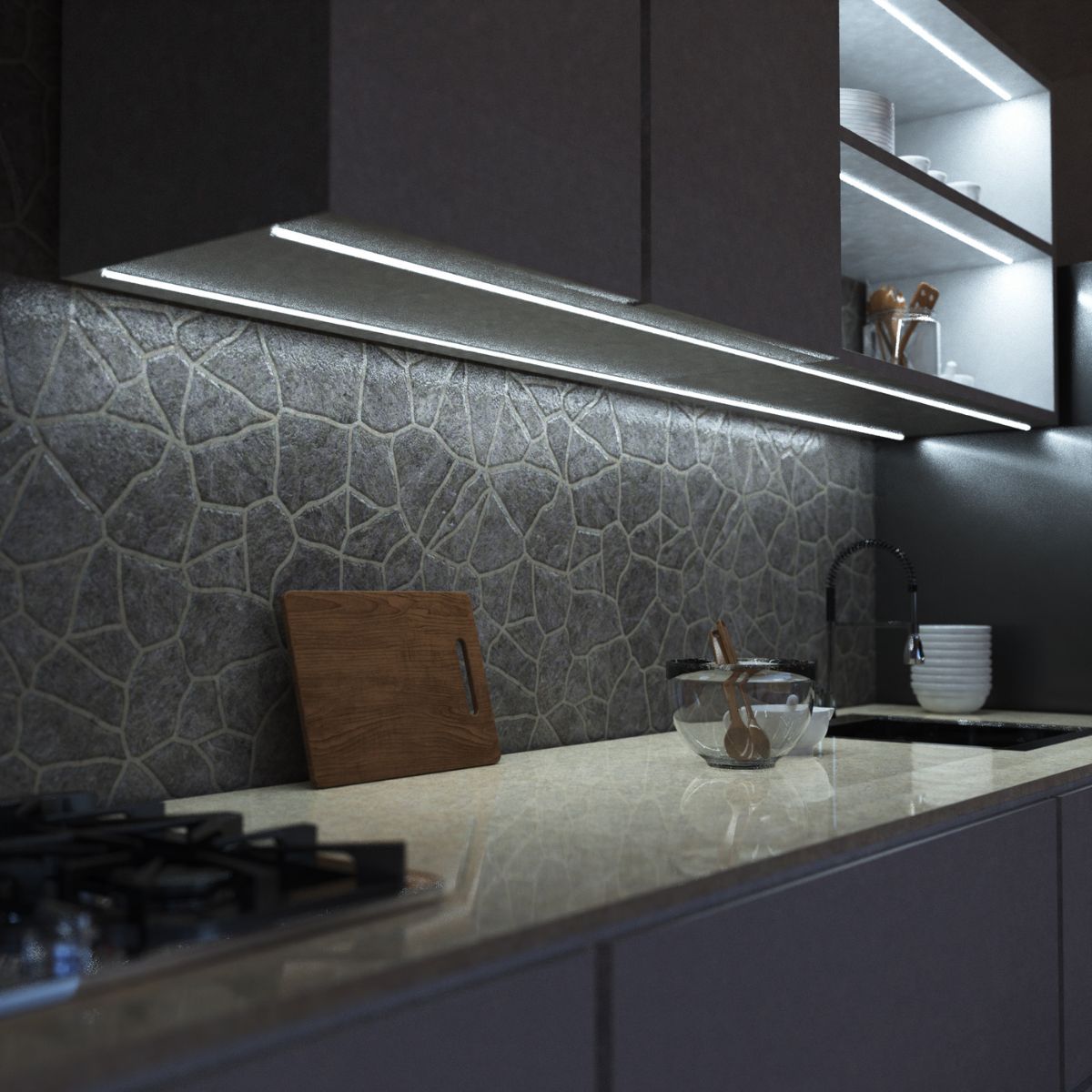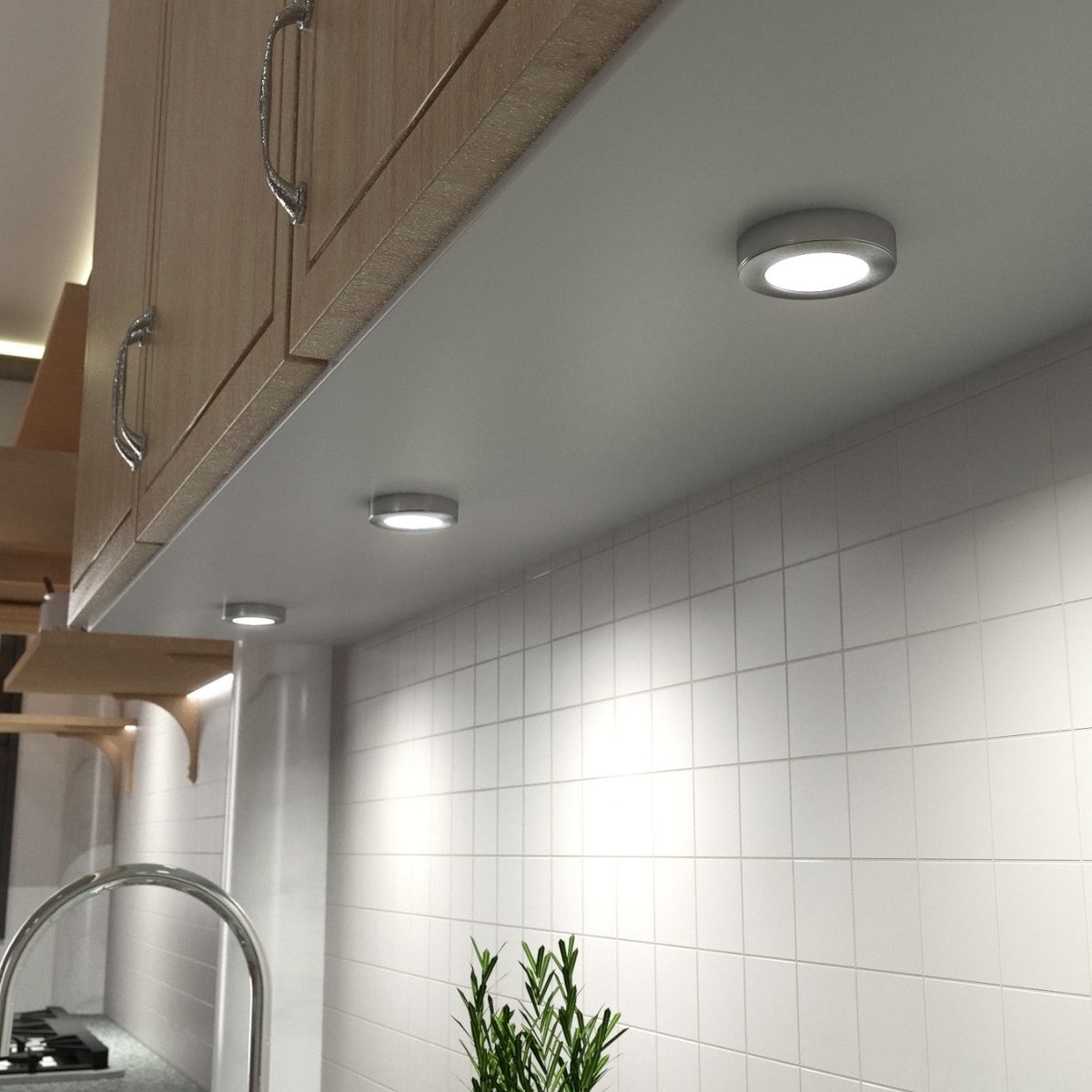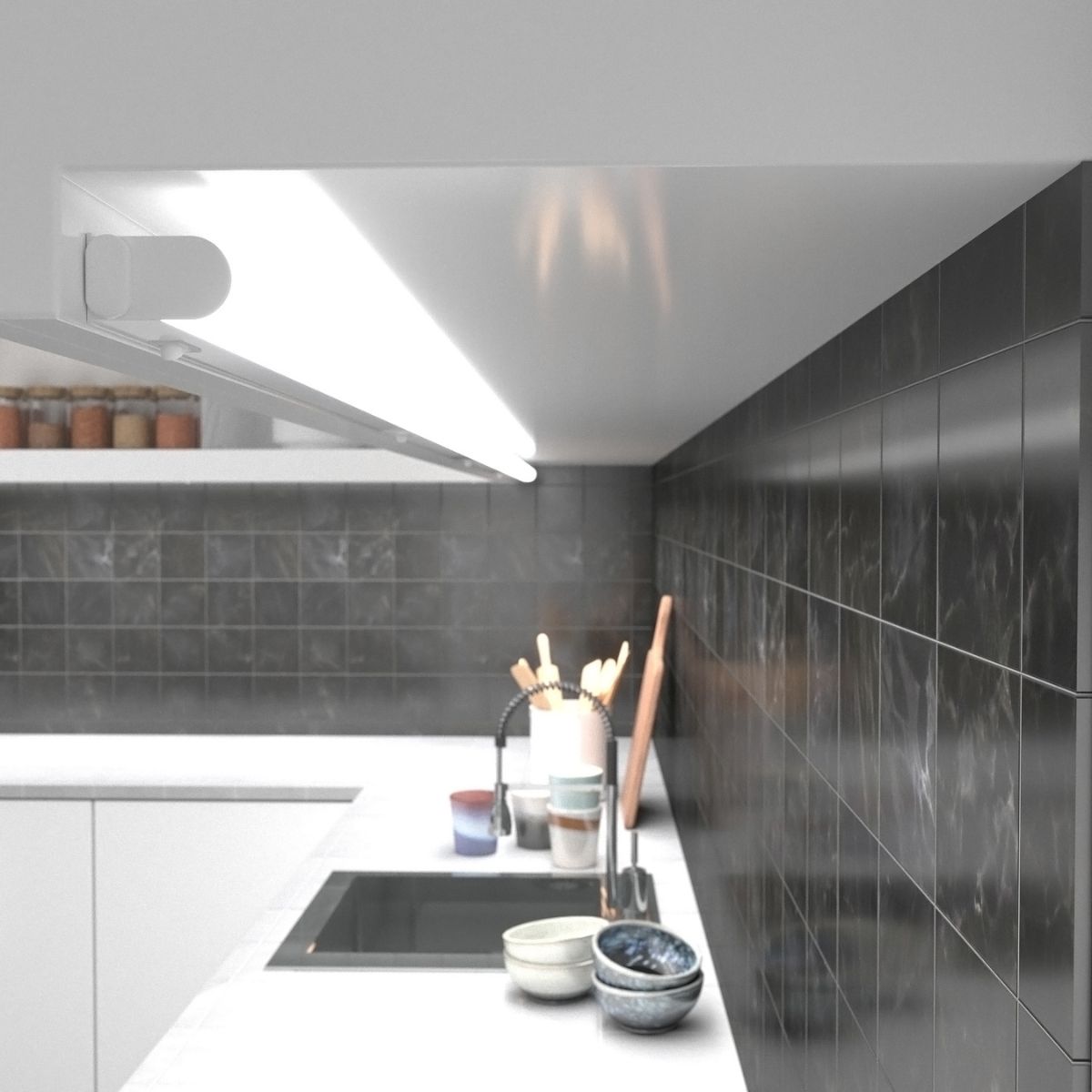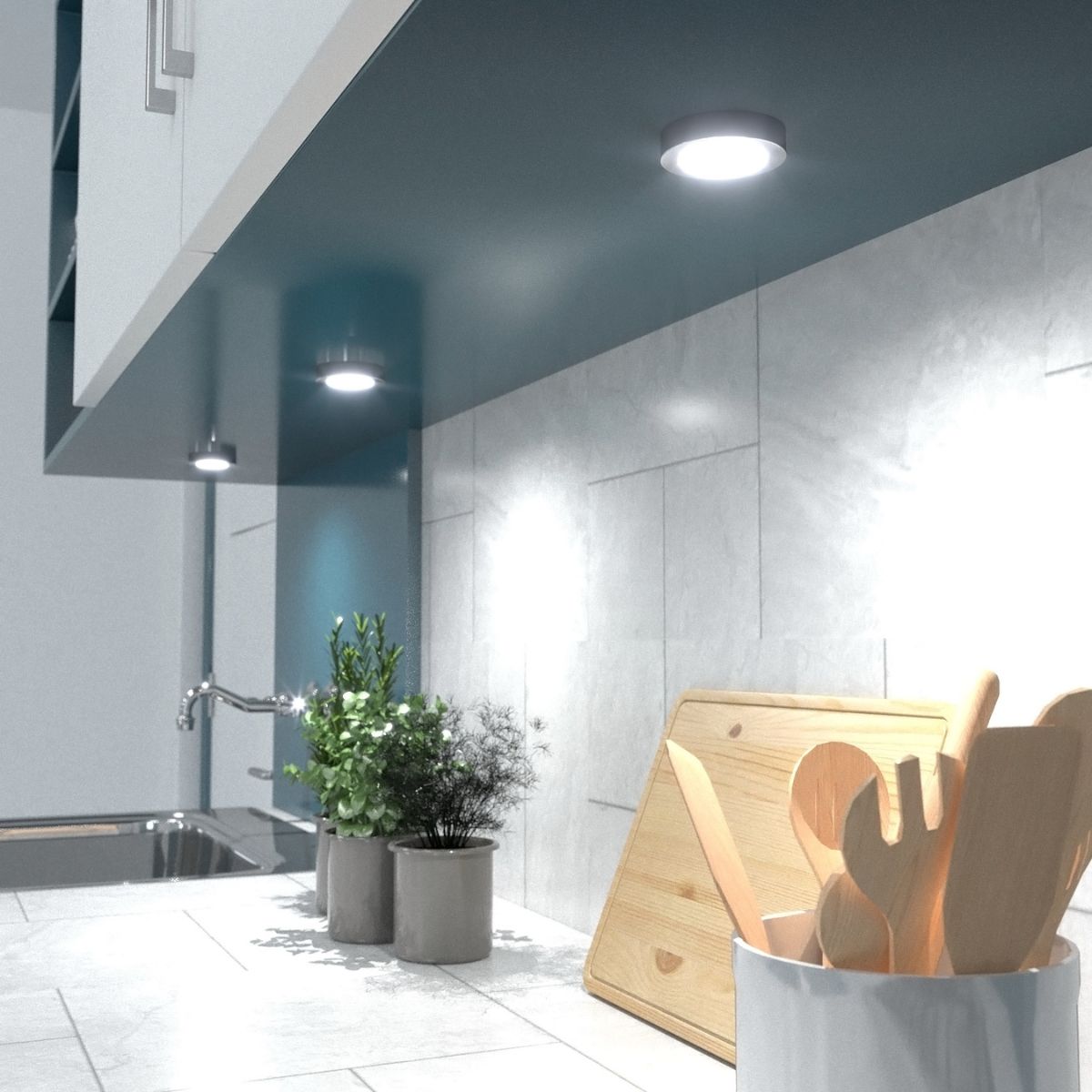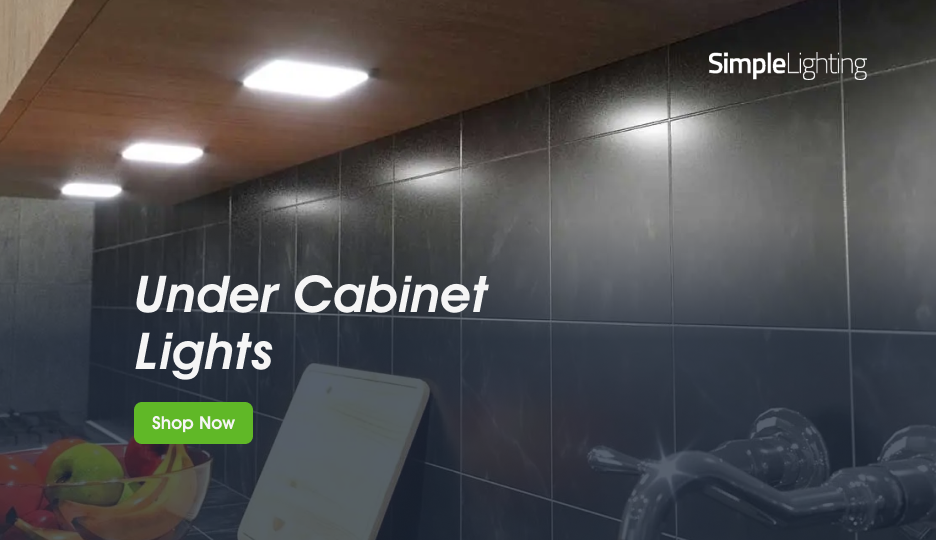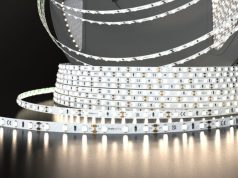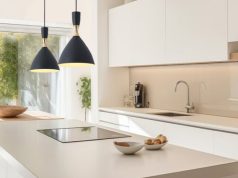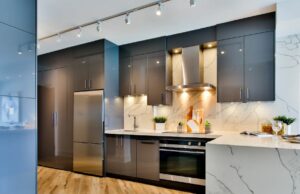Most people think that the key to having a kitchen that feels luxurious and inviting is, well, getting luxurious cabinets, appliances, and utensils.
They’re wrong.
What’s the key, then? Proper lighting. When it comes to kitchen design, lighting isn’t just a finishing touch. A few lighting upgrades can make a big impact on your kitchen. And one of the crucial lights to have in that space is under-cabinet lighting.
Forget having only one powerful overhead light source. Under-cabinet lighting makes chopping vegetables, wiping down worktops, and setting the mood for a cosy evening easier.
It’s the difference between having a “flat” looking kitchen and one with depth. It also ensures that your worktops always have good visibility, keeping all kitchen tasks safe. Kitchen style doesn’t matter. Having the right under-cabinet light can completely take it from normal to high-end.
In this guide, we’ll uncover all the important things you need to know about under-cabinet lighting: What they are, the different types, ideal placements, some design inspiration, and more.
Ready to level your kitchen? Let’s dive in.
Why Under-Cabinet Lighting Matters
It’s often overlooked, but under-cabinet lighting is one of the smartest investments you can make for your kitchen.
Here’s why:
1. It Improves Task Lighting
What’s below your overhead/hanging cabinets? Your kitchen countertops. They’re where the real work (chopping, mixing, measuring, and cooking) happens.
And guess what happens when you add under-cabinet lighting? You get focused illumination directly over your worktops, ensuring you can prep food safely and accurately!
With bright, even task lighting, every detail, from knife skills to colour contrast, becomes easier to see. It’s about convenience, yes. But it’s also about functionality and safety. Probably even more on the latter.
2. It Enhances Aesthetic Appeal
Under-cabinet lights aren’t just practical. They also add a layer of visual sophistication.
They highlight the textures and colours of your splashback, worktops, and cabinetry, creating depth and ambience. Subtle yet impactful, under-cabinet lighting can completely transform the mood and character of your kitchen.
3. It’s Energy-Efficient and Versatile
Modern LED under-cabinet lighting offers brilliant illumination at a fraction of the energy cost of halogen or fluorescent alternatives.
LEDs stay cool to the touch, last up to 50,000 hours, and come in a wide range of colours, brightness levels, and designs. The kicker? They’re very low maintenance and have maximum efficiency.
Everything you could ask for in a light source.
Types of Under-Cabinet Kitchen Lighting
Not all under-cabinet lighting is made for your kitchen. It’s essential to understand the difference between each type to decide which one suits your space best.
Each type offers unique benefits for style, installation, and function after all.
LED Strip Lights
LED strip lights are one of the most popular and versatile choices for under-cabinet applications.
These flexible strips come with adhesive backing, making them easy to mount along the underside of cabinets, shelves, or even inside plinths.
There are plug-and-play LED strip lighting kits you can buy for easy mounting and use. LED strips are also available in a variety of colour temperatures, from warm white to daylight cool.
You can also install them inside aluminium profiles and diffusers for a more professional finish. This not only enhances the look but also protects the LEDs and softens the glow of the strip.
They’re perfect for:
- Modern and minimalist kitchens
- Long countertops need uniform lighting
- Accent lighting inside or under open shelving
Puck Lights
If you’re looking for more compact lighting, then puck lights might suit your needs. They’re circular and ideal for creating focused pools of light under cabinets.
Why is it called “puck”? The name comes from their shape, similar to a hockey puck. They’re typically mounted in small groups or evenly spaced rows.
Puck lights can either be surface-mounted or recessed, and they have a more defined light compared to strips. This makes them great for spotlighting specific areas, such as a coffee station, chopping zone, or display cabinet.
What are they perfect for?
- Traditional kitchens where you want visible, elegant fixtures
- Highlighting decorative items or specific work areas
- Smaller cabinet sections or corners
LED Linear Lights
If you don’t mind having a visible fixture, then batten lights can be a great choice for your under-cabinet lighting.
They’re rigid fittings that deliver bright, even illumination. They’re often used in both domestic and commercial settings because they’re powerful, durable, and easy to install.
Linear lights are great if you prefer strong, practical task lighting on your countertops. And that’s not even the best part: They can also link together for a seamless look.
They’re perfect for:
- Large workspaces or utility areas
- DIY-friendly installations with simple mounting brackets
Recessed Profiles and Channels
If you want a clean, professional-looking finish, then LED strip lights housed in recessed LED aluminium profiles or channels are your go-to.
The profile acts as a heat sink (improving lifespan) and includes a diffuser that softens light to reduce glare and hotspots. The result is a pristine look that’s perfect for modern kitchens that prioritise clean lines and minimalist detailing.
They’re perfect for:
- Luxury or contemporary kitchens
- Clients or homeowners seeking a professional finish
Choosing the Right Colour Temperature
How does lighting control the atmosphere or the mood of a space? Colour temperature. This can make or break the mood of your kitchen.
It’s measured in Kelvin (K), and each category can affect your space differently from the others. There are three colour temperatures: warm white, natural white, and cool white.
Warm White (2700K-3000K)
Warm white light has a soft, golden glow, similar to traditional incandescent bulbs. It can create a relaxing and inviting atmosphere. This is great in traditional kitchens with wood tones, making the space feel homey.
Natural White (4000K)
Natural white strikes a balance between warm and cool tones. It offers natural, balanced task lighting that’s perfect for food preparation without being too harsh. This makes it a popular choice for under-cabinet lighting in most kitchens.
Cool White (5000K-6000K)
Cool white light has a crisp, bluish tone that enhances visibility and gives a modern, high-contrast look. It’s particularly effective in contemporary or minimalist kitchens with white gloss finishes, metal accents, or clean design lines.
If this is confusing for you, just remember that the lower the colour temperature is, the more amber the light becomes, and the higher the temperature, the more bluish the light is.
Quick Tip:
If you’re unsure which to choose for your under-cabinet lighting, go for natural white (4000K). It complements most materials, looks natural in daylight, and supports both task and ambient lighting.
Placement and Installation Tips
So now, after everything you’ve read above, you want a smooth, functional, and beautiful under-cabinet lighting. Correct placement and installation are crucial for achieving that.
Lucky for you, we’ve got some pointers:
Positioning for Maximum Effect
To maximise visibility and reduce shadows, make sure to install your lights in a way that the light spreads evenly across your worktops.
Strips or battens should be run continuously along the cabinet base to avoid patchy illumination. For puck lights, space them evenly to avoid gaps and achieve balanced coverage.
Avoiding Shadows & Glare
Shadows occur when you position your light sources too far back, or when you don’t use diffusers.
To avoid this, use under-cabinet lights with diffusers or aluminium profiles with built-in diffusers for LED strips to achieve a soft, even glow.
If you have a reflective wall or splashbacks, make sure your lights aren’t facing them directly to avoid bright, blinding reflections (a.k.a. glare).
Opt for warmer or diffused light to maintain comfort and ambience.
Wiring & Power Considerations
Most LED under-cabinet lights operate on low voltage (12V or 24V), which requires a compatible LED driver or power supply.
Never overload your driver. Always check your total wattage and give your driver a 20% safety margin to avoid problems.
For neat results, conceal wires within the cabinet recess or along the back edge. And if you’re not into complex wiring, you can always get plug-and-play LED kits for easier DIY installation.
Design Ideas & Creative Uses
You may be installing your under-cabinet lights for their function, but they’re more than that. They’re creative design tools.
Here are some ways to make your lighting scheme stand out:
- Got glass-front cabinets? Illuminate them to display glassware or ceramics inside.
- Highlight open shelving with warm LED strips for a soft evening glow.
- Fun, customisable effects are achievable with colour-changing RGB LED strips.
- Integrate smart control so you can dim lights, change colour temperature, or schedule them for automatic lighting.
Pro Tip:
Combine under-cabinet lighting with pendants, ceiling spots, or plinth LEDs to create a layered, professional look that balances practicality with style.
Common Mistakes to Avoid
Even the most luxurious under-cabinet lights can produce terrible light quality if installed improperly.
Here’s a list of what to avoid:
1. Using the wrong colour temperature — Cool white in a warm-toned kitchen can feel harsh, while warm light in an ultra-modern space can look dated.
2. Uneven or patchy illumination — Caused by gaps between LED strips or poorly spaced puck lights. Correctly measure your space before installing your lights.
3. Overly bright lighting without dimming — Without a dimmer, your lighting may feel clinical or too intense. Besides, do you always need super bright lights in all the areas of your kitchen? A lot of times, nope.
4. Visible wiring or unfinished profiles — Always hide cables and don’t sleep on diffusers if you want that clean, professional aesthetic.
5. Ignoring compatibility — Ensure your LED driver, dimmer, and lights are all compatible in voltage and wattage. Never use incompatible ones to keep your lights safe.
What do you get by avoiding these pitfalls? You get to make sure that your kitchen lighting looks seamless, intentional, and long-lasting.
Conclusion
You don’t necessarily need expensive items for a kitchen with a luxurious feel. You just need the proper lights installed. And under-cabinet lighting is undeniably one of the most effective ways to enhance both the beauty and functionality of your kitchen.
It improves visibility, adds warmth and depth, and highlights your kitchen’s best features…
All while keeping energy consumption low. Whether you choose sleek LED strips, focused puck lights, or bright batten fittings, the key is thoughtful design. Always consider your kitchen’s style, colour palette, and how you use the space daily.
Just remember these essentials:
- Choose the right type for your layout.
- Match the colour temperature to your design.
- Install lights evenly across the surface for uniform illumination.
- Use profiles, diffusers, and dimmers for professional results.
When planned well, under-cabinet lighting doesn’t just make your kitchen brighter, it makes it smarter, more stylish, and more enjoyable.
At Simple Lighting, we offer a wide range of flawless under-cabinet lighting that’s perfect for any kitchen design.
Whether you’re renovating your kitchen or upgrading your current setup, you can’t go wrong by getting the right under-cabinet lights installed.


